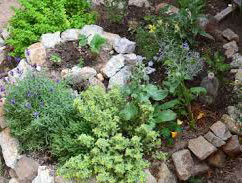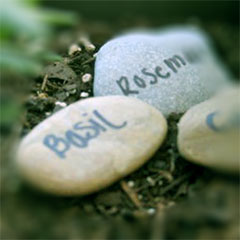
Fast-growing herbs are something you can still get started on in autumn as all they need is some sun and regular water plus in spring you will have early herbs ready for cooking and salads when all other vegetables are in short supply.
A Spiral Herb Garden is an ideal solution for small gardens or for keeping a variety of herbs handy to your kitchen and also enables you to maintain a good supply without much effort. The design also creates different micro-climates suitable for the different growing requirements for each type of herb.
Create your own spiral by using old bricks, logs of wood or garden rocks or even large pebbles.
Once built a spiral garden is easy to maintain and harvest from as long as you keep it no more than one metre in diameter, any larger and it becomes too hard to reach in and clip what you need.
The location is important. Your spiral should receive all-day sun, be close to your kitchen door and handy to a tap or hose. Herbs planted well away from the house or kitchen door are hardly ever used.
To build your spiral:
- Gather enough of the same material in the form of old bricks, rocks, large pebbles or even logs of wood.
- Compost
- Garden soil
- Old concrete rubble or stones, anything inert that will not leach anything into the garden.
- Herb plants
2) Make a one metre in diameter base with the old rubble then pile on the garden soil – make about a half metre high mound and compact it down with the back of spade or you feet.
3) Using the bricks, rock, or logs of wood create a spiral starting on the outside use extra layers of bricks or larger rocks on the outside and fill up with compost as you wind in a gradually up to the centre. Fill any gaps with small rocks or part bricks. Any remaining hollows fill with more compost.
4) Now you have niches all over the spiral perfect for planting herbs.
Herbs that love hot dry conditions such as sage, thyme or rosemary plant near or on the top on the northern side of the spiral. Plants that require some shade but need dry feet such as aloe vera, coriander and rocket plant slightly lower down on the southern side. Other herbs that require a wetter clime, such as mint, plant at the bottom so that as you water from the top down they will receive the most water.
Basil, parsley, chives like a medium spot somewhere in the middle.
Maintenance:
Water regularly from the top down and once the plants are established clip regularly to use in your salads, teas and cooking. Regular clipping encourages bushy growth and prevents the herbs from going to seed.
 TIP: Use a permanent marker or be even more creative and paint the names of the different herbs onto the stones or bricks that are alongside each herb.
TIP: Use a permanent marker or be even more creative and paint the names of the different herbs onto the stones or bricks that are alongside each herb.
Painting the names of herbs or other plants onto pebble is a good project for Art and Crafts class and can be a good fundraiser at school fetes. Also makes a perfect but inexpensive Mother’s Day Gift.
– Happy herb planting
From
The Kitchen Garden Gnome


